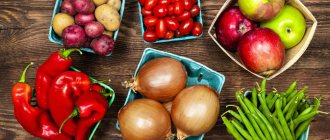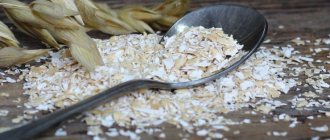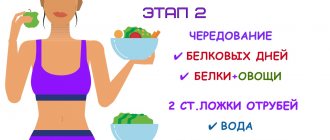What are the benefits of Soviet Union diets?
It was in the USSR that the so-called tables appeared, which many have heard of. Number tables are still used in the treatment of various diseases. We must remember that the USSR was the first country that bothered to take care of developing a diet at the state level. Remember that Thursday was fish day in the USSR? All canteens fed workers fish dishes. This was the Decree of the People's Commissariat of Food Industry.
Moreover, then ordinary women did not have personal nutritionists, pills and weight loss products, or detox centers. But many actresses of that time had very good figures. And this is based not on overseas dishes, but on simple, widely available products and iron willpower. The list of Soviet diets will take more than one page, so let’s look at the most popular diets of the Soviet era.
“Table number eight” according to Pevzner
Manuil Pevzner was the chief nutritionist in the USSR. It was he who decided that the best routine would be three meals a day. He is also the author of the idea of a three-course lunch: first, second and compote. Pevsner first developed the idea of "tables" which were used to treat common illnesses. Of these, table No. 8 stands out - the main diet of the USSR. It was used to combat obesity.
Stew, bake or boil foods, fried foods should not be eaten, reduce calories and eliminate fast carbohydrates - these are the basic rules of nutrition according to Pevzner. The conditions within table No. 8 allowed us to eat 5–6 times a day. If the case was advanced and the fat had to be removed quickly, the diet was reduced to 1200 calories, and the person was sent to a medical facility.
Prohibited foods included all baked goods, sugar and everything containing it. In addition to fast carbohydrates, you should not eat meat with a lot of fat, all confectionery products, semi-finished meat products, hot or fatty sauces, fatty milk products and some cereals (white rice and oats). The amount of salt was reduced and spices were minimized.
The approximate schedule of table 8 for the day looked like this:
- For breakfast we eat low-fat cottage cheese with vegetable salad.
- 3 hours after breakfast, the second breakfast comes, and here we eat a few apples.
- For lunch we eat borscht with lean meat. Only low-fat sour cream is added to borscht. As a second course, some boiled meat and stewed cabbage.
- For an afternoon snack we drink low-fat kefir.
- For dinner, boiled or baked fish, complement it with vegetable salad. Alternatively: buckwheat and steamed veal cutlet.
- Before bed, a glass of skim milk.
As you can see, this Soviet diet resembles proper nutrition with a priority content of protein products in the diet. The Pevzner diet is very gentle. You will not feel hungry. Weight loss on table No. 8 - 2 kg per month. The duration of such nutrition can be very long, even throughout life. It does not contain harmful carbohydrates, which in any case are healthier to exclude. According to BJU, everything is balanced - there is an abundance of vitamins, microelements and fiber. USSR diet products and menus can be changed to alternative ones. Fish for chicken breast, cottage cheese for natural yogurt and kefir.
Lyubov Petrovna and her diet
In the 30s, the idol of girls throughout the country was the famous actress Lyubov Orlova.
Naturally, everyone also wanted to become like her. — breakfast and lunch only; — two days a week on the water; - breakfast: a glass of water with lemon juice, two boiled eggs, a slice of bread; - lunch: 100 g of lean meat, some vegetables.
The actress never tried to adhere to any rules, but still, over time, this diet was given the name Orlova.
Soviet diet for quick weight loss for a week
This diet is sometimes called the “cosmonaut diet” or “astronaut diet.” It is more commonly known as “my grandmother’s diet.” Represents a typical protein seven-day period. True, today we don’t have to worry about frying meat in a dry frying pan, but start a double boiler; this will not make any fundamental changes to our diet.
Breakfast: black tea with a sugar substitute (at that time saccharin was in use, which had a strong laxative effect. If you are not afraid to add a little carbohydrates to your diet, you can take sorbitol, the result will be about the same). 100 g cheese. (meaning regular rennet cheese, “Russian”, “Poshekhonsky”, etc.).
- Lunch: 100 g of beef in a dry frying pan, cucumber.
- Dinner: either 2 eggs and 1 tomato, or 100 g of boiled sausage, also with tomato.
There are "versions" of this diet with chicken instead of beef, and fish instead of the "sausage dinner". The essence does not change - losing weight involves a sharp elimination of carbohydrate foods that retain water in the body. The diet can be harmful for diseases of the kidneys, liver, heart, and stomach. Almost certainly, such weight loss provokes constipation, so modern adherents of protein diets also eat bran powder with breakfast.
Mono-diet on parsley
After the end of the war, people who got rid of constant stress were able to think about proper nutrition again. And although after general militarization, sports figures “a la a girl with a paddle” became popular, after the appearance of Lyudmila Gurchenko, women began to desire a slender, thin figure. And the “Twiggy syndrome” did not bypass the Soviet Union.
Of course, other actresses copied Gurchenko’s image. And it was the fragile Lyudmila Markovna who began to appear on TV more and more often. Losing weight, as always, was not easy, and those who wanted to gain a slim figure came up with new diets. Although nutritionists advised against resorting to extreme methods, mono-diets have become very popular. And the Soviet diet based on parsley became the most popular.
But the discussion here was not about parsley leaves, but about the roots, which should have been eaten grated. The root was eaten three times a day. You cannot live long on parsley alone, so you could eat other permitted foods, but in small quantities, no more than 200 g per day. Those allowed included healthy sources of protein such as cheese, lean meats, eggs and dairy products.
Since, apart from parsley, there are no vegetables or fruits, vitamin deficiency may appear, and therefore you cannot go on a diet for a long time, like on any other mono-diet.
An approximate schedule for one day looks like this:
- for breakfast, one tablespoon of mashed parsley, washed down with tea or coffee;
- for lunch we take another tablespoon of root and 100 g of boiled meat;
- for an afternoon snack, along with a spoon of root, 100 g of dairy products, for example, cottage cheese or cheese;
- For dinner we drink a glass of low-fat kefir.
Plisetskaya's diet
Maya Plisetskaya is the most famous ballerina of the 20th century. In the 60s, a Soviet weight loss diet named after her appeared, which many believe was developed by Plisetskaya. It is difficult to verify whether this is true or not, but this power system was very popular in Soviet times.
It must be said right away that this system is not designed for long-term use; it is rather a plan for a fasting week. The program also had nutritional instructions after the diet - it was recommended to eat more fish and fiber, and also exclude salt from the diet, large quantities of which accumulate water in the body.
It was also recommended not to overdo it. After the fasting week, you could leave your favorite dishes in the diet if they were low-calorie. Meal times also mean little, and nothing was said about snacking or eating before bed.
On a fasting diet, eat three times a day. You can have snacks, but you can’t eat too much. For snacks, eat only non-starchy types of vegetables and fruits, such as cucumbers, tomatoes or citrus fruits.
An important part of this Soviet diet is exercise, which is necessary if weight loss is slow. The effect will not be as noticeable if you neglect exercise.
An example of a menu on this diet:
- For breakfast we eat 100 grams of Hercules cereal, boiled in water and without added sugar.
- For lunch - a plate of vegetable soup and 100 g of vegetable salad.
- For dinner, some baked fish and 60 g of rice. Garnish with fresh vegetables.
Diet Guide for Losing Weight 8
What is possible
- Light varieties of cheese.
- Lean chicken, turkey and beef.
- Sauce (tomato and vegetable).
- Boiled eggs and omelet with vegetables.
- Compotes, jellies and sweet and sour berries.
- Seafood.
- Fermented milk drinks with reduced fat content.
- Salads, casserole and vegetable stew.
- Vegetable soups with a small addition of potatoes.
- Rye bread and crispbread.
What is strictly prohibited
- Jam.
- Ice cream.
- Salty and fatty cheeses.
- Cheesecakes.
- Smoked fish and canned food.
- Pasta.
- Fried potatoes.
- >Sausages and salami.
- Fatty meats.
- Sweet juices, tea and coffee with sugar.
- Mayonnaise, mustard and ketchup.
- Salo.
- Cakes and puff pastries, white bread, pancakes.
- Grapes and bananas.
When creating a menu for diet No. 8, choose products from the permitted group. It is necessary to observe the number of meals and their calorie content.
Diet of fashion models in the USSR
In the Soviet Union there were no models, but fashion models. Let's remember them. Regina Zbarskaya, the most beautiful weapon of the Kremlin, Galina Milovskaya, Soviet Twiggy, Tatyana Mikhalkova, wife of the famous director, Leokady Mironov, who was one of the first to be offered contracts by Western agencies, Elena Metelkina, who starred in the film “Through Thorns to the Stars,” Tatyana Chapygina, the most popular model of the USSR, which always appeared on the pages of “Working Woman” and “Peasant Woman”.
The diet of Soviet fashion models was used by them before the show and limited caloric intake for three days. The sample menu used by the most beautiful models of the Union looked something like this:
- Breakfast – one soft-boiled egg.
- The second breakfast, which came three hours later, was 180 g of low-fat cottage cheese.
- Lunch, again after about three hours - 200 g of boiled poultry or palm-sized fish; you can supplement lunch with a glass of tea or a cup of coffee without sugar.
- Afternoon snack, three hours later, we eat a soft-boiled egg again.
- And after another three hours we eat 180 g of cottage cheese and tea.
As you can see, the diet is protein, and no carbohydrates.
We use this nutrition program for three days, apply it once a month. It will take 3 kg.
Moscow Art Theater diet
Actors and actresses have always strictly monitored their weight. The students of the acting department of the famous Moscow Art Theater were no exception.
– 1 day: 2 liters of fresh milk (short shelf life)
— Day 2: 2 kg of apples
— Day 3: 300 grams of cheese
— Day 4: 2 kg of vegetables (cucumbers, carrots, cabbage, tomatoes, etc.; season with a few drops of oil, lemon juice, spices, no salt)
— Day 5: 200 grams of boiled meat or fish
— Day 6: 200 g of cottage cheese, 2 hard-boiled eggs
— Day 7: 300 grams of cheese, 12 bottles of dry wine
This diet cannot be repeated more than once every couple of months, otherwise the body begins to wear out. Its effectiveness is quite high - in just a week, a fasting person loses up to 4 kg of excess weight.
Diets born in the USSR were very popular then, but they still work great today.
IMPORTANT! Informational article! Before use, you should consult a specialist.
Soviet eating habits that are ruining the lives of you and your children
Everyone who was born during the Soviet era or grew up in the 90s knows the immutable formula for lunch: first course, second course and compote. This approach to nutrition seems to have become part of our DNA. Together with the project “Healthy Eating from A to Z” and nutritionist and endocrinologist Anastasia Guseva, we will understand what proper nutrition is and how to turn bad eating habits into healthy ones.
Useful Mela newsletter twice a week: Tuesday and Friday
SUBSCRIBE
340 million worldwide - that's how many children suffer from obesity today. In Russia this is about 5.5 million children, and their number is constantly growing. Why is this happening? Partly due to the lack of a healthy lifestyle culture. For example, many simply do not see a problem with eating a large dinner before bed.
At the same time, every year both adults and children move less and less: gadgets cope with most routine tasks, and you can study and work without leaving the couch. We also inherited some habits from our grandparents that only add to our health problems.
And take some bread
The eared field became a symbol of peace, fertility and well-being of the Soviet people: texts in school textbooks were (and still are) dedicated to grain growers, and even small children know that bread should not be thrown away.
Yes, bread was a very important part of the diet. Sometimes the only one. Now there is no need to supplement any meal with bread, but this habit is still strong at home, and in many kindergartens and schools. Breakfasts, lunches and dinners are still accompanied by trays of sliced bread, and children snack on bread between meals.
Today, the choice of bread and other flour products is very wide, but not all of this wide range is suitable for proper nutrition. In the production of white bread, for example, highly refined wheat flour, which is low in nutrients, is sometimes used. It's of little use. And most often we eat it.
What instead.
“If you want a balanced diet, then choose quality bread, preferably made from whole grains or alternative flours. Sourdough used instead of yeast will also help reduce the load on the gastrointestinal tract. And children often love crispy whole grain breads. Remember that the main principle of proper nutrition is variety. So, if you allowed yourself a couple of slices of fragrant sliced borscht, it’s okay.”
Another bad habit that we inherited from Soviet times is the habit of snacking on sandwiches. Remember those sandwiches wrapped in a napkin? Nourishing, but also not the best option. Now there are many opportunities to replace the sandwich with something healthy, for example, drinking yogurt or cottage cheese satisfies hunger well. You can put a banana, an apple, and dried fruits in your child’s lunchbox. Remember, everything should be in moderation.
Well, and most importantly, parents cannot demand that their children eat healthy if they themselves constantly eat everything with bread. A parent is a key role model for a child, so it’s worth assessing your eating habits first.
Three course lunch
The tradition of set meals of three courses with the obligatory compote and rich soup originates from factory canteens of the USSR. For those who worked hard all day, a lunch with plenty of carbohydrates and fats was especially important. Just for energy and performance. Children then spent much more time in the yard and led a more active lifestyle - this also required a plentiful diet.
The legendary “Book of Tasty and Healthy Food” made a three-course meal a culinary commandment of the Soviet citizen. In addition to recipes, it contained “the basics of rational nutrition” - a section justifying the science and reliability of the book, which talked about vitamins and the daily calorie intake (huge by modern standards - 3500 kcal per day).
Today, with a sedentary lifestyle, such dense meals, in addition to oversaturation, can lead to obesity and problems with the cardiovascular system.
What instead.
“It is optimal to calculate the required daily amount of calories, divide it into a comfortable number of meals and enjoy it. At first, it can be really difficult to take containers of food with you to school and work, let alone having to cook it. But it easily becomes a habit.”
“If you decide to help your child change their eating habits to healthier ones, be patient, because you won’t be able to do this by magic. However, there are some little tricks here, which we tell parents about in the “Healthy Eating from A to Z” project. If you don’t know where to start, take an online intensive and get the knowledge you need, advice from psychologists and nutritionists,” invites project manager Valentina Bogomolova.
Concentrates and canned food
In Soviet times, a wide variety of canned and semi-finished products were produced for polar explorers, geologists and all those who worked far from grocery stores and supermarkets. The popularity of backpacking has made stew a truly iconic dish. Plus, it successfully replaced meat that was disappearing from stores.
Modern canned fish and meat often contain a lot of sugar, salt and other additives to preserve the taste. There is another problem - the low quality of raw materials, which are used by unscrupulous manufacturers and which are sometimes difficult to verify.
But there is good news: there are enough conscientious producers on the market who use high-quality vegetables and meat, and, on the contrary, do not favor preservatives and chemicals. The main thing is to carefully read the composition.
What instead.
“The easiest way to protect your child (and yourself) from harmful canned food is to carefully read the label. You can and even should stock up on healthy canned vegetables - read the ingredients carefully (there should be no artificial preservatives) and do not forget that fruits and vegetables in the winter in the form of high-quality canned food contain even more vitamins than fresh ones on the shelves.”
Sweet compotes and soda
An indispensable element of a Soviet lunch is dried fruit compote in a faceted glass. Or fruit drink. Or jelly. There was little choice in the USSR. Today, the shelves are full of packaged juices and sweet soda.
It’s definitely worth doing without soda. It contains a lot of sugar - this can cause problems with the endocrine system and will certainly affect the condition of the pancreas. The composition of such drinks usually includes citric and phosphoric acids, which irritate the mucous membrane of the stomach and esophagus. Regular consumption of sugary carbonated drinks in children can be one of the causes of tooth decay.
What instead.
“If possible, give preference to juices, preferably with pulp. They contain a lot of inulin, a fiber found in fruits and vegetables that is good for the gastrointestinal tract. It’s good if you managed to accustom your child to vegetable juices: they contain much less sugar. But we still shouldn’t forget about the importance and benefits of water.”
"Dumplings with mazik"
Mayonnaise is originally a cold sauce made from egg yolk, olive oil, lemon juice or vinegar, salt and sugar. Tasty, filling and inexpensive, it has become a favorite dressing for Mediterranean residents.
He was also loved in the Soviet Union. Not a single Olivier salad or herring under a fur coat could do without it. However, this product contains large amounts of fat, salt and sugar. For example, it is not recommended to give it to children at all - for the same reasons.
What instead.
“If you still really want Olivier or herring under a fur coat, you don’t have to deny yourself the pleasure. Use yogurt as a dressing: it is lighter and healthier in composition. Or you can make any other homemade sauce.”
“Healthy Eating from A to Z” is an all-Russian project to teach schoolchildren the principles of proper nutrition and the formation of healthy habits.










